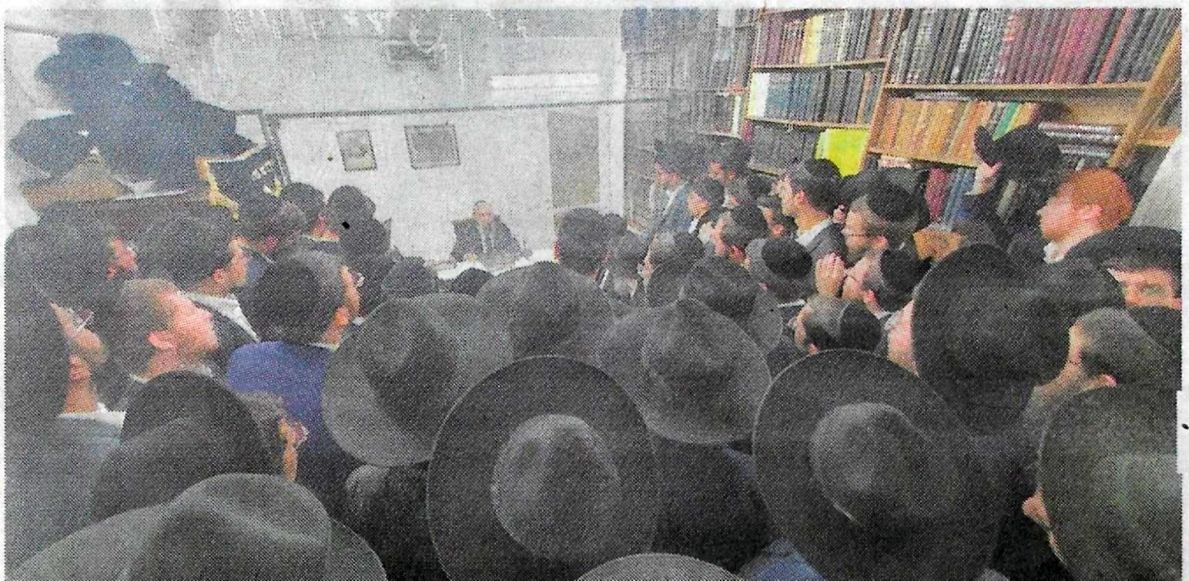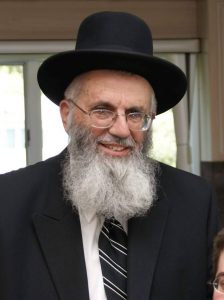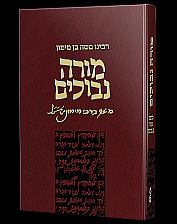| |
This Google Custom Search looks only
in this website.
HaRav Gershon Eidelstein: Message for Shavuos
HaRav Gershon Eidelstein cordially and affably received the rabbonim and talmidim of Yeshivas Nachlas Binyomin from Modi'in Illit, of which he has served as president since its formation.
This time he delivered a talk to the visitors, students and rabbonim of Nachlas Binyomin, which is so dear to his heart, to prepare them for the upcoming Shavuos. It dealt with the acquisition of Torah, how to obtain these principles and how to fortify themselves in these days.
He began with a greeting:

Learning the Lessons of Meron: Improvements at the Kosel
Preventing a [possible] future calamity: the Deputy Transportation Minister and head of the Chareidi Authority and the organization for Road Safety, Rabbi Uri Maklev, met with Jerusalem mayor Moshe Leon and the rabbi of the Kosel and Holy Sites, Rabbi Shmuel Rabinowitz, to examine ways to improve access to the Kosel during peak times so as to minimize the overcrowding which exists at such times.
Other bodies joined this meeting so as to view the subject in its full intricacies: professionals from the municipality, the Chareidi Authority, the Moriah company, a team of the master plan for transportation, commanders from the Israeli Police Department responsible for safety at the site, and Rabbi Dovid Zohar, member of the Jerusalem administration from the Degel HaTorah party and holding the office of municipal transportation.
A Life's Work: Improving Our Middos
Improving ourselves is a task that is always in season, but it is especially appropriate as a preparation for kabolas haTorah. This essay and several more that will, iy'H, follow in the coming weeks, explains the basis for our obligation to work on improving our character, and the framework in which we should do so. One of the most important lessons is that we must turn to the Torah for guidance in middos — as in everything else in life. The following is based on tapes of shmuessen that were delivered at the Yeshiva of Staten Island. It was originally published in 1996.
Part I
It is very important to work on our middos. Each person must know that he or she has a chiyuv — a real obligation — to work on middos and he must be sure to do so.
A time that is especially appropriate to work on middos is during sefiras HaOmer. The gemara in Yevomos says: "Shneim osor elef zugim talmidim" — Rabbi Akiva had 12,000 pairs of talmidim, "vekulom meisu beperek echad mipnei shelo nohagu kovod zeh bozeh" — they all died in one time period because they did not treat each other bekovod.

* * *
|
From Our Archives |
|
Call for Awakening in a Time of New Decrees
from HaRav Michel Yehuda Lefkowitz Zichron Meir Bnei Brak
This letter was issued by HaRav Lefkowitz to provide encouragement and guidance in these difficult times.
BS'D, 11 Iyar 5763
First of all we must reflect. As the Tribes of Israel did when it says: "And they turned, trembling, to each other saying, `What is this Elokim has done to us?'" (Bereishis 42:28). Undoubtedly Hashem's actions toward us have a purpose based on the will of the Creator.
Thus Chazal said all events are middoh keneged middoh to allow us to understand and know why Elokim [acts toward us in a certain way] and to know what to rectify. This is what we say in Selichos, "Umimakoh atzmoh mesaken retiyoh" (from the Selichos of the first Monday of Bahab). Chazal say, "The ways of Hashem are not like the ways of flesh and blood. The way of flesh and blood is to strike with a knife and heal with a bandage, but HaKodosh Boruch Hu heals with the same implement with which he strikes, as is written, `And they came to Moroh and they were unable to drink the water, for it was bitter.' Says Rav Levi, 'The generation was bitter in its ways and it cried out to Hashem . . . '" (Shemos Rabboh, 50, 3). [And eventually Hashem showed them a bitter tree that sweetened the water.]
During the last several decades, our way of life has changed. We have grown accustomed to luxuries of all sorts--clothing, furniture, weddings, apartments, and much more. Competitiveness among ourselves has increased to the point where everyone lives in comparable circumstances, the haves and even the have- nots.
|
Falsehood has Twins: A true story, believe it or not
by S. Eishel
The familiar fragrance of food laid out on tables greeted her as she entered the Beit Hachlama. Her heart leaped up at this warm welcome.
"Here, lay your baby down in bassinet No. 12 and you can go right into the dining room."
She laid down the tiny creature which had received the name No. 12, as it would be called until she left this place, and went over to the woman at the desk, whom she already knew from previous visits.
"Oh, hello! How are you! Mazel tov! What is it this time, a boy or a g..?"
She interrupted her in the middle. "Yochy, do me a favor. I desperately want to be alone in a room but a private room costs almost double and I hope to stay here for a few days. Please try to put me in a room for two which is still unoccupied at the moment. Let me have at least one night's uninterrupted sleep," she begged. She needed some real, deep sleep, and with another person in the room, she knew she wouldn't get it.
|
The Royal Garb: Getting Dressed for Shabbos and Yom Tov
by Rabbi D. Travis
The daughter of a prominent Torah personality once asked her father if she could travel to England to visit her grandparents. The Rov replied that he was willing to let her go, but that she would have to earn the trip. While she started making the calculation of how many hours she would have to baby-sit to cover the airfare, her father explained that he was not referring to a monetary commitment. He wanted her to go to the queen's palace and see two things: the changing of the guard and the crown jewels.
Seeing that his daughter was somewhat startled by his request, the Rov continued, "Our Sages have told us that the majesty of Hashem is reflected by human sovereignty" (Brochos 58a). Today's high-tech world has left us little of the overwhelming sense of awe experienced upon witnessing monarchy. Anyone who has the opportunity to lay his eyes on royalty firsthand, has seen a gem much more valuable than the crown jewels."
We cannot imagine a king without scepters, crowns, emeralds and diamonds, for these are the physical manifestations of the royalty that Hashem has bestowed upon him. The halacha, in fact, rules that when in the presence of a king, even a blind person can make the brochoh of, "Who gives over of His Honor to those that fear Him," for a person without vision can still sense the overwhelming air of royalty that emanates from a king (Mishna Berurah 224:11).
Similarly, special Shabbos and Yom Tov clothing enable us to recognize Hashem's majesty, as they create a distinctive ambience. In addition, they provide us with a constant reminder of the day's kedusha, so that we do not come to transgress it with forbidden melochos (Kol Bo, Mitzvas Shabbos).
|
| |
POPULAR
EDITORIALS
Av, 5765 - Kislev 5766 (August-December 2005)
|






.jpg)

